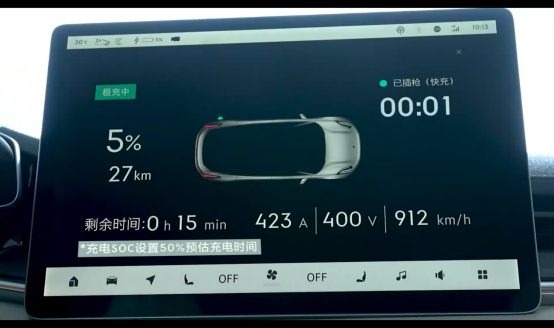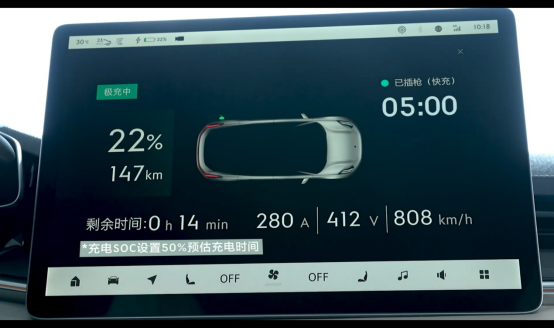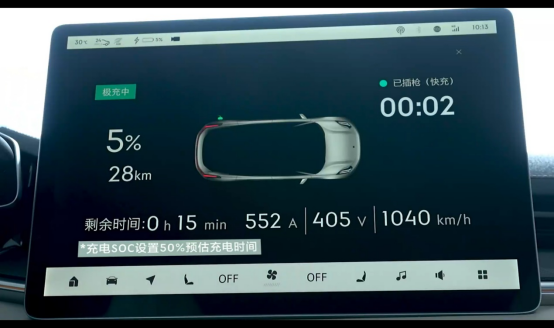Author: Chris
Editor: Chris
On July 1st, Jiqi TOP 100 exposed the screenshot of Jiqi 001’s fast charging.
When the remaining battery power is 5%, Jiqi 001’s charging current is 552A, charging voltage is 405V, and charging power is 223 kW.
Although the market for intelligent electric vehicles is rapidly expanding, consumers’ understanding of technologies such as motors, batteries, and fast charging is still far behind that of engines, transmissions, and gasoline. Therefore, each of these numbers, 405V, 552A, 223 kW, is worth discussing.
“400V? 800V?”
“Supported by an 800V high-voltage architecture, the Porsche Taycan can support 350 kW fast charging.” Even in the delivery stage, Porsche reduced the peak power of Taycan’s ultra-fast charging to 270kW, but this globally-leading ultra-high power still makes consumers remember the 800V.
Moreover, as the trend of pure electric vehicle industry, major automakers around the world are shouting for the 800V high-voltage architecture. The maximum system architecture of General UItium platform, Hyundai E-GMP architecture, and GAC Group’s SEA Haohan architecture all support up to 800V- Jiqi 001 is a model developed under the SEA architecture.
What does 800V mean for consumers? According to the middle school physics formula P=UI, while keeping the current (I) unchanged, doubling the system voltage (U) can increase the charging power (P) by twice. The 800V architecture allows your car to be charged at a higher speed in a shorter time.
The benefits of the 800V architecture go beyond this. A complete 800V architecture, combined with SiC power modules, can give a pure electric vehicle more space for high-performance and lower energy consumption.
Since 800V is so good, why are some high-performance pure electric vehicle models that will be launched in 2021 and even 2022 not using the 800V architecture?
For example, the NIO ET7, which will be launched in 2021 with a starting price of 4.48 million yuan and a total power of 480 kW for the front and rear motors, still uses the 400V architecture.# If the persuasiveness of ET7 is not strong enough…
On June 11th, Tesla started delivery of the new Model S Plaid, with a total power of 1020 horsepower from its front and rear three motors. From any perspective, the Model S Plaid sets a benchmark for electric vehicles – but it still uses the 400 V high-voltage architecture.
Of course, the 400 V camp also includes the protagonist of this article, the Xpeng P7.
The reason why Xpeng P7 still uses the 400 V architecture is simple: 800 V is the future, but now is the present.
A complete 800 V architecture requires a large number of high-voltage devices to match and assemble. In a pure electric vehicle, except for the 12V small battery that powers lights, instrument panels, and central control screens, all other components related to “electricity” are part of the high-voltage system architecture.
Switching to an 800 V system architecture is not as simple as “developing a new power battery and increasing the parallel voltage to 800 V”. A series of high-voltage components, such as onboard chargers, air conditioning compressors, IGBT power modules, and high-voltage driving circuits that were originally based on a 400 V architecture, need to be replaced and upgraded to the 800 V architecture.
For the current electric vehicle supply chain, 800 V is still immature. Of course, “forcing” 800 V can be viable, but it requires a certain brand premium and pricing ability. The only mature and mass-produced pure electric vehicle model on the market is the Porsche Taycan, which starts at a price of 888,000 yuan.
Even after solving the product issues, there is still an important problem that affects the user experience of 800 V electric vehicles: in China, the development of ultra-high-voltage charging stations that meet the 800 V high-voltage architecture is very limited. This will make the 800 V architecture, which requires a lot of effort to land and deploy, unable to fully demonstrate its overall capabilities in charging, putting the charging experience at the edge of “pioneering” and “martyrdom” in the long term.
To sum up, after balancing performance, technological complexity, industrial maturity, cost, and user experience, the best pure electric vehicle architecture today is undoubtedly still the 400 V architecture.
Of course, to achieve a good user experience, a significant investment in research and development is necessary, and the 400 V architecture is no exception.
“552A”## Video Screencap
The maximum current of Jikua 001 in the video screencap is 552A, while the peak current design of Jikua 001 disclosed by Jikua officials is 600A.
What is this concept? In the standard of DC fast charging pile in GB/T 20234.3-2015, the maximum current is only 250A. You may say, isn’t the standard of 2015 a bit outdated? Okay, what about the new national standard DC fast charging ChaoJi released by State Grid in March 2020? What is the maximum current? 600A.
It needs to be explained here that as a charging technology standard for the next decade, the maximum power design of ChaoJi reaches 900kW, the maximum voltage reaches 1,500V, and the maximum current, which is the same as Jikua 001 today, is 600A.
As for the formula P=UI mentioned earlier, when the voltage of 400V is blocked, Jikua chose to increase the value of the current to obtain a supercharging capacity of over 200kW.
However, doubling the current will also bring a series of problems. First, the charging line of the mainstream 2015 national standard DC pile is already thick and bulky. Keeping other conditions constant and doubling the current will cause a significant increase in the heat generated by the entire charging cable. Charging piles need better heat dissipation capabilities.
On the one hand, we need faster charging capabilities and larger currents, which will bring more heat generation. On the other hand, we need lighter and more compact charging cables. The contradiction between high current and small wire diameter is irreconcilable.
The solution is liquid cooling. Tesla, GAC Aion, TELD, Jikua, NIO, many intelligent electric vehicle companies are deploying liquid cooling high-current supercharging. The principle of liquid cooling is simple. A layer of liquid cooling pipeline is wrapped outside the charging cable to immerse the cable. This greatly improves the heat dissipation capability.
In fact, with the support of liquid cooling, although the current has doubled, the wire diameter has the opportunity to be smaller and lighter.
Judging from the line diameter of the supercharging pile shown by Jikua, the cable diameter of Jikua is estimated to be similar to that of Tesla V3 supercharging pile, which makes the process of charging plug-in guns more convenient than the current mainstream fast charging piles.At the launch event of JiKe 001, the peak power of the design of JiChong station reached 360 kW. Although the fast charging capability of 001 also reached the industry’s top level, what happened to the promised 360 kW?
In fact, the reason is simple. From JiKe’s perspective, on the one hand, JiKe has an obligation to solve the energy supplement needs of users in all car use scenarios. This has led to the emergence of JiChong centers/stations (240 kW – 360 kW), super charging stations (90 kW – 120 kW), light charging stations (20 kW), home charging piles (7 kW – 22 kW), and worry-free charging (mobile charging vehicles) that charge the fastest. The more numerous forms of energy supplements, the more detailed the breakdown of car use scenarios.
On the other hand, JiKe had previously announced that it will launch at least two new models every year for the next five years. From the perspective of dynamically understanding the role of business-owned energy supplement networks, JiKe needs to leave some redundant capacity to ensure that today’s infrastructure can also provide full power services for future models.
Considering these factors, JiKe temporarily passed on 800V and developed a liquid-cooled high-current route. Can the 223 kW supercharge shown in the JiKe video be put into use?
In terms of battery, JiKe 001 is equipped with Ni 55+ ternary batteries, which can support a fast charging rate of 2.2C. In addition to the battery, the wire, the entire charging circuit’s gun + wire, the EVI port, the high-voltage connector, the circuit relay, and the fuse all need to be technologically optimized.
Whether it is high voltage or high current, supercharging is a system engineering.
Finally, let’s take a look at the 223 kW itself. Let’s take a look at the fast charging curve designs of two car manufacturers that are relatively distinct.
This is the Audi e-tron fast charging curve, which can be stabilized at 150 kW from 0-80%, gradually decreasing after 80%, and can still maintain a charging capacity of 50 kW displayed on the car even at 100%.
The other is the curve of Tesla’s V3 supercharging pile. The peak power output is maintained from 0-20%, gradually decreasing after 20%, and the supercharging power will also drop to single digits at the 100% displayed on the panel until it reaches 0 kW.# Results
The video data of the fast charging on Juicedie K01 cannot sample a complete 0-100% supercharge curve. However, it can be seen that Juicedie’s supercharging route is closer to the latter, providing rapid energy replenishment for low-battery state by increasing the peak power in the initial stage.
Before this, Juicedie had announced that Juicedie K01 has a 5-minute charging and 120 km replenishment capability.


From the video test results, after being fully charged for 5 minutes, the battery life of Juicedie K01 increases from 5% to 22%, and the increased cruising range is 147-27=120 km, which is consistent with the official promise.
Finally, let’s summarize the 400V high-current supercharging of Juicedie K01, which achieves the best balance between user experience and mass producibility.
It sounds like another story of balancing multiple perspectives and interests, but hasn’t the automotive industry always been dancing with shackles?
This article is a translation by ChatGPT of a Chinese report from 42HOW. If you have any questions about it, please email bd@42how.com.
